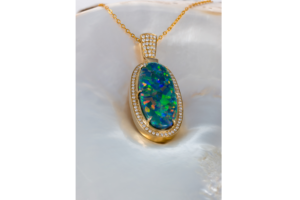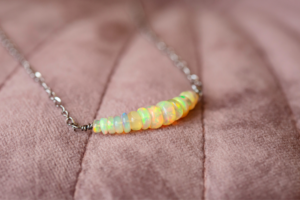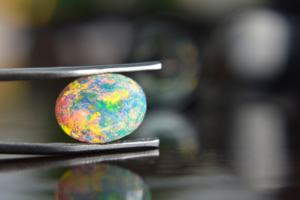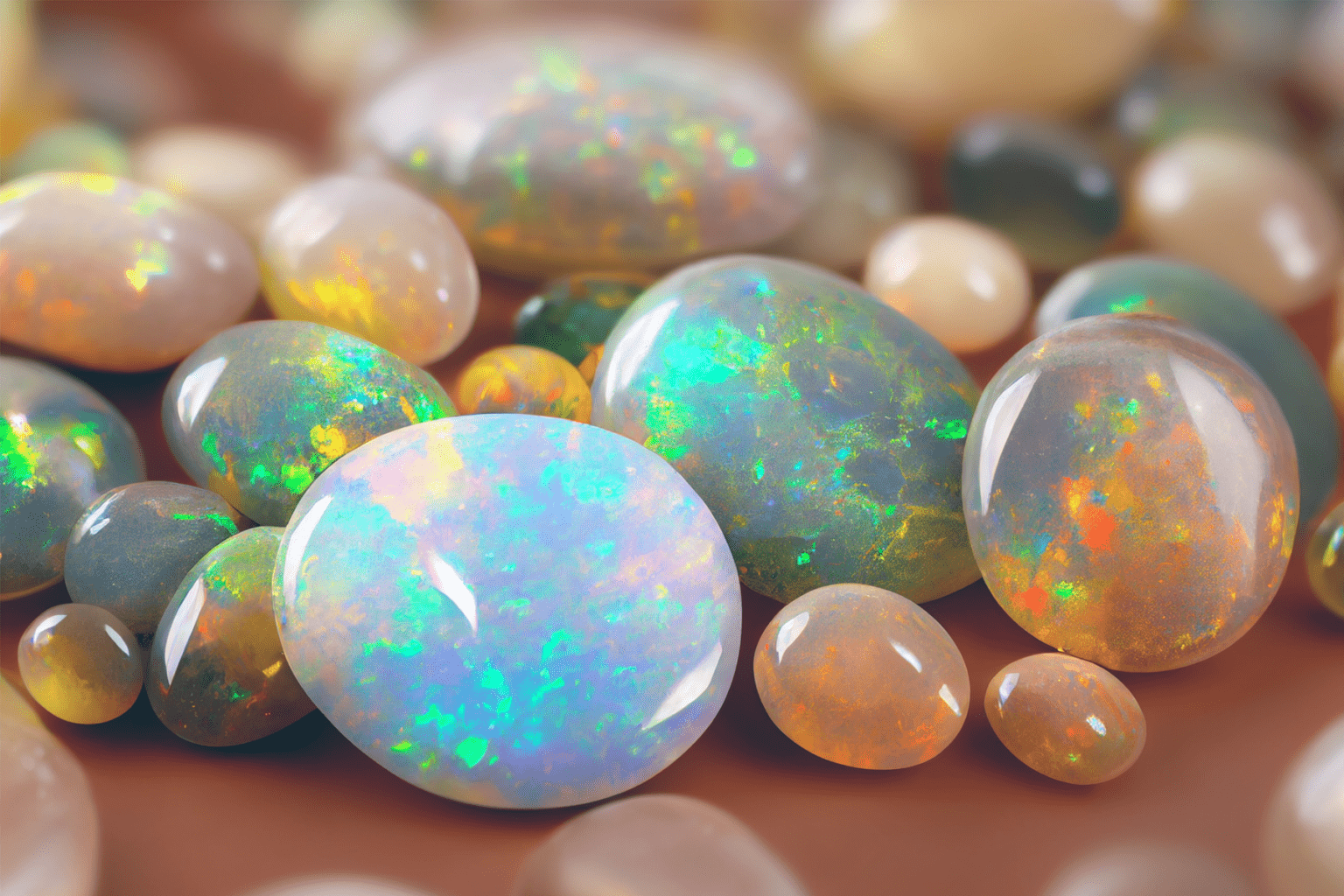Opal’s Formation
Opal is formed when silica-rich water seeps into cracks and voids in rocks, such as sandstone or basalt, and then evaporates over time, leaving behind deposits of silica in the form of tiny spheres. These spheres then become tightly packed together and form a three-dimensional lattice structure.
The unique play of color seen in opals is due to the way that light interacts with this lattice structure. As light passes through the tiny spaces between the silica spheres, it is diffracted into a rainbow of colors, creating the iridescent effect that opals are famous for.
The colors seen in opals depend on a variety of factors, including the size and spacing of the silica spheres, the presence of impurities, and the angle at which the light hits the opal.
 Is opal a birthstone?
Is opal a birthstone?
Yes, opal is a birthstone. In fact, it is one of the two birthstones for the month of October, with the other being tourmaline. Opal is also the traditional gift for the 14th wedding anniversary. The beauty and uniqueness of opal make it a popular choice for jewelry, especially for those who celebrate their birthday in October or who are looking for a unique and eye-catching gemstone to wear.
Colors of Opal
Opals can come in a wide range of colors, and the exact colors depend on a variety of factors such as the type of opal and the location where it is found.
White opals, which are the most common type, are usually white or light-colored with flashes of iridescent colors such as blue, green, and pink.
Black opals, which are the most valuable and sought-after type, have a dark body color that ranges from dark gray to black, with flashes of bright color.
Other types of opals include crystal opals, which are transparent to translucent and have a play of color within a clear or slightly milky background; boulder opals, which form as a thin layer of opal on a host rock such as ironstone or sandstone; and fire opals, which are a translucent to transparent orange or red.
Opals can also have a mix of colors, and some may even have a rainbow-like pattern of colors. The exact colors and patterns in an opal can be influenced by a variety of factors, including the location where it was formed, the conditions under which it formed, and the presence of impurities or other minerals.
Do the colors have different meanings?
In some cultures and traditions, different colors of opal are believed to have different meanings or properties. However, these meanings can vary depending on the culture or individual belief system, and there is no universally accepted system of assigning specific meanings to different colors of opal.
In general, though, opals are often associated with mystical and spiritual properties, and are believed to have a range of benefits including enhancing creativity, promoting emotional balance, and helping to relieve stress and anxiety.
Some people believe that white opals are associated with purity, innocence, and clarity of thought, while black opals are associated with protection, grounding, and the ability to deflect negative energy. Other colors of opal, such as blue or green, may be associated with specific meanings such as calmness, healing, or growth.
Ultimately, the meaning and significance of opal color is largely a matter of personal interpretation and belief, and can vary widely between individuals and cultures.
The Shapes of Opal
Opals can be cut and polished into a variety of shapes, depending on the desired use and the characteristics of the stone. Some of the most common shapes for opals include:
- Oval: Oval-shaped opals are the most popular shape for opal gemstones. They are versatile and can be set into a variety of jewelry designs, such as rings, earrings, and pendants.
- Round: Round opals are also popular for use in jewelry, especially for earrings or as a centerpiece in a pendant.
- Pear: Pear-shaped opals have a teardrop shape and are often used in earrings or pendants.
- Cabochon: A cabochon is a smooth, rounded gemstone that is not faceted. Cabochon opals are often used for rings and pendants, and can be cut into a variety of shapes, including oval, round, and pear.
- Freeform: Some opals are cut into irregular, organic shapes, known as freeform. These can be used in unique, one-of-a-kind jewelry designs.
- Fancy: Fancy-shaped opals can be cut into a variety of shapes, such as heart, triangle, and hexagon. These shapes are less common but can be used to create unique and interesting jewelry designs.
The shape of an opal will depend on the size and shape of the rough stone, as well as the desired use and style of the finished piece of jewelry.
What chakra is associated with opal?
Opal is said to be associated with the crown chakra, which is located at the top of the head and is associated with spiritual awareness, consciousness, and enlightenment. The crown chakra is considered to be the highest chakra, and is believed to be the point where an individual connects with their higher self or the divine.
Opal is said to help activate and balance the crown chakra, allowing energy to flow freely through this energy center and promoting spiritual growth, intuition, and a deeper sense of connection to the universe. It is also believed to promote emotional balance and mental clarity, which can support spiritual development and help individuals to connect with their true purpose and path in life.
The Benefits of Using Opal
Opal is believed to have a range of benefits for the mind, body, and spirit. Here are some of the potential benefits of opal:
- Emotional Healing: Opal is said to promote emotional healing, especially in areas related to love, relationships, and self-esteem. It is believed to help soothe emotional wounds and promote a greater sense of self-love and acceptance.
- Spiritual Growth: Opal is associated with the crown chakra, and is said to promote spiritual growth and connection to the divine. It is believed to help awaken intuition, enhance psychic abilities, and promote a deeper understanding of the self and the universe.
- Creativity: Opal is believed to enhance creativity and inspiration, making it a popular choice for artists and creatives. It is said to stimulate the imagination and promote new ideas and perspectives.
- Calming and Soothing: Opal is believed to have a calming and soothing energy, which can help to reduce stress and anxiety. It is said to promote a sense of inner peace and relaxation, and can be used to support meditation and other mindfulness practices.
- Physical Healing: Opal is believed to have physical healing properties as well, and is said to support the immune system, aid in digestion, and promote healthy skin and nails.
Cleansing Opal
Opal is a delicate gemstone, and care should be taken when cleaning it to avoid damaging the stone. Here are some methods for cleansing opal:
- Mild Soap and Water: Opals can be gently cleaned with a mild soap and water solution. Use a soft-bristled brush, such as a toothbrush, to gently clean the surface of the stone. Rinse thoroughly with water and pat dry with a soft cloth.
- Dry Cloth: A soft, dry cloth can be used to gently wipe the surface of the opal. Be sure to avoid using any rough or abrasive materials that could scratch the surface of the stone.
- Water and Ammonia: A solution of water and ammonia can also be used to clean opals. Mix equal parts water and ammonia, and soak the opal for a few minutes. Rinse thoroughly with water and pat dry with a soft cloth.
- Ultrasonic Cleaner: An ultrasonic cleaner can be used to clean opals, but care should be taken to ensure that the stone is not damaged by the vibrations. It is best to use a mild cleaning solution and to avoid leaving the stone in the cleaner for too long.
- Avoid Harsh Chemicals: Opals should never be cleaned with harsh chemicals or solvents, as these can damage the stone. Avoid exposing opals to high heat or extreme temperature changes, as these can also cause damage.
It is important to note that opals should be handled with care, as they are a delicate gemstone that can be easily damaged. If you are unsure how to clean your opal, it is best to consult with a professional jeweler who can provide guidance on the proper care and cleaning of the stone.
Channeling Opal’s Energy
The energy of opal is said to be gentle and nurturing, and can help to balance and align the chakras. Here are some ways to channel the energy of opal:
- Wear Opal Jewelry: One of the simplest ways to connect with the energy of opal is to wear opal jewelry, such as a ring, necklace, or earrings. The stone can be set in gold, silver, or other metals, and can be worn daily to help align and balance the chakras.
- Meditate with Opal: Opal can be used in meditation to help calm the mind, balance the emotions, and promote spiritual growth. Hold the stone in your hand or place it on your chakra points while meditating to help focus your energy and intention.
- Place Opal in Your Environment: Placing opal in your environment, such as on a bedside table or in a meditation space, can help to infuse the space with the stone’s nurturing and balancing energy.
- Carry Opal with You: Carrying a small piece of opal with you, such as in a pocket or purse, can help to keep you connected to the stone’s energy throughout the day.
- Use Opal in Energy Healing: Opal can be used in energy healing practices, such as reiki or crystal healing. The stone can be placed on or near the body to help balance the chakras and promote healing and wellness.
It is important to note that the exact method for channeling the energy of opal may vary depending on the individual and their specific needs and intentions. It is always recommended to work with a qualified practitioner or teacher when exploring energy work and crystal healing.
Opal’s History
The history of opal is rich and varied, and the stone has been revered for its beauty and mystical properties for thousands of years. Here are some key moments in the history of opal:
- Ancient Rome: The ancient Romans prized opal for its beauty and believed that it symbolized hope and purity. They called the stone “opalus,” which means “precious stone,” and used it in jewelry, cameos, and other decorative objects.
- Ancient Greece: The ancient Greeks believed that opal gave its wearer the power of foresight and prophecy. They also believed that opals were formed from the tears of joy wept by Zeus after his defeat of the Titans.
- Medieval Europe: During the Middle Ages, opal was believed to bring good luck and protect against harm. It was often set into jewelry and worn as a talisman.
- 19th Century: Opal became very popular in the 19th century, especially in Europe and the United States. The discovery of black opal in Australia in the late 1800s caused a sensation, and the stone became highly prized for its intense play of color.
- Modern Day: Today, opal is still highly valued for its unique beauty and mystical properties. It is often used in jewelry and decorative objects, and is a popular choice for those looking for a unique and eye-catching gemstone.
Opal has been associated with a range of beliefs and traditions throughout history, including healing, protection, and spiritual growth. Its mystical properties have inspired people around the world for centuries, and it remains a beloved and fascinating gemstone today.
 Summary
Summary
Opal is a gemstone that has been revered for its beauty and mystical properties for thousands of years. It has been used by ancient cultures such as the Romans and Greeks, and during the Middle Ages it was believed to bring good luck and protect against harm. In the 19th century, the discovery of black opal in Australia caused a sensation, and the stone became highly prized for its intense play of color. Today, opal is still highly valued for its unique beauty and mystical properties, and is often used in jewelry and decorative objects. It is associated with a range of beliefs and traditions throughout history, including healing, protection, and spiritual growth.

